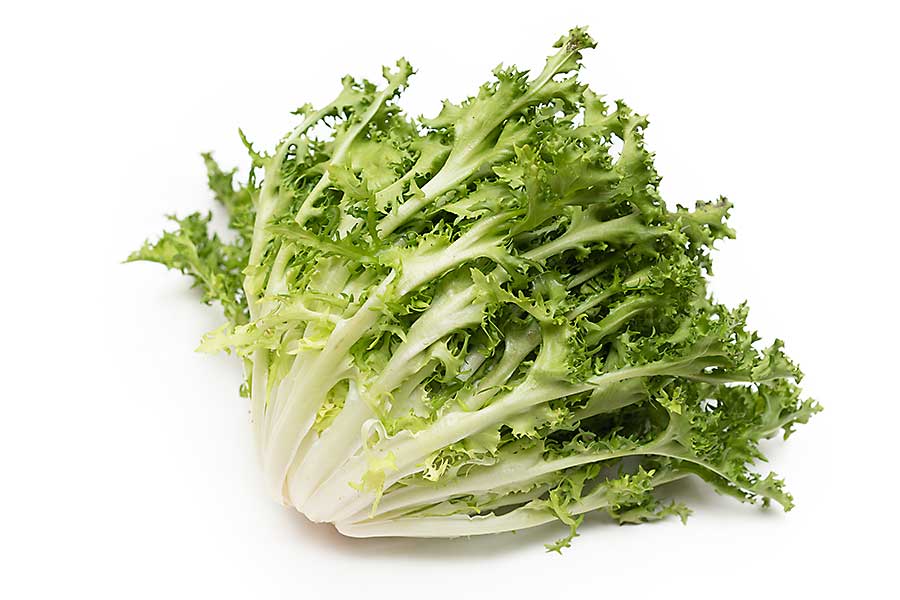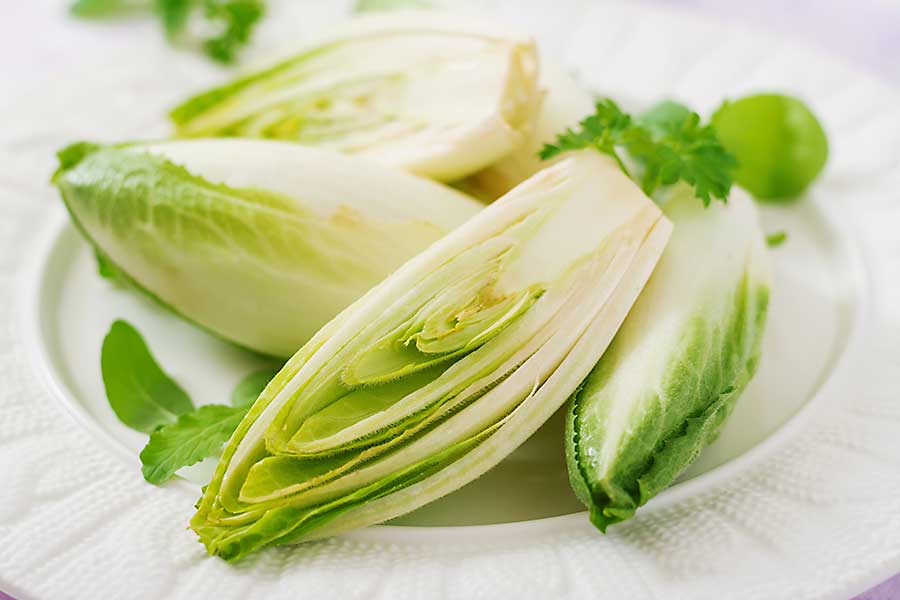Endive
Endive is a type of leaf vegetable which belongs to the Cichorium genus, a group that includes other bitter leafed vegetables. There are three main varieties of Endive, including Cichorium endivia (endive), Cichorium pumilum (wild endive), and Cichorium intybus (common chicory). The third type of endive encompasses other varieties such as radicchio, Belgian endive, and puntarelle. In modern culinary usage, the term endive simply refers to the leafy portion of any plant that falls within the chicory family.
The characteristic flavour of endive is its bitterness, which varies depending on the type that is cultivated. This bitterness makes endive a top choice in balancing and contrasting different flavours, helping to enhance the overall taste of a dish. This bitterness can be countered by cooking the vegetable, allowing for a sweeter and nuttier flavour to come through.
Like mushrooms, endive is grown in dark, cool, and humid rooms.
The three main types of endive
There are three main types of endive used in cooking. The first two main varieties fall within the Cichorium endivia endive family. The first is known as curly or frisée endive, and has thin, green, and curly outer leaves. This type can often be confused with common chicory. The second type, escarole, is also known as broad-leaved endive and features wider leaves that are paler in colour and less bitter. The third popular endive used in cooking is the common chicory or Belgian endive.
Escarole or broad-leaved endive
This variety of endive is less bitter than the other two types, featuring light green leaves on the inside and darker leaves towards the outside. The paler inner leaves are easier to chew and can be served raw, chopped in salads. The darker, outer leaves are more bitter than the inner leaves and can be harder to chew. For this reason, they are most often served cooked, usually in soups.
Curly or frisée endive
This variety of endive is bushier than the other two, with delicate curly leaves that are almost lace-like in texture. Again, the darker leaves are often more bitter than the lighter coloured leaves. This type of endive is sometimes referred to as chicory, and in the UK it is simply called endive. Curly endive is most popularly used in salads to add flavour and texture.
Belgian endive or common chicory
Belgian endive, or common chicory resembles a lettuce head. The leaves are yellowish and slightly curled at the tip. This type of endive has a moderate and delicate bitterness compared to the other two varieties. Again, Belgian endive can be served in salads or also baked on its own and served as a side dish or appetiser. The lettuce-like head of Belgian endive can also be brushed with a sauce or vinaigrette and grilled, served as an accompaniment to seafood. Reddish varieties of this type of endive are known as radicchio.
Health benefits of endive
Endive is a low calorie vegetable that is high in complex fibres. The fibre content of the leaves aids in digestion and helps to improve the overall digestive system. It is favoured in many diets as it can help produce a feeling of fullness, encouraging weight loss. The fibre content also reduces blood cholesterol and controls blood sugar levels, therefore reducing the risk of heart disease.
Endive is also rich in vitamins A, C, and E, including provitamin A. Provitamin A, also known as retinol, is helpful in improving vision and skin complexion. Vitamin C promotes the formation of collagen, also aiding in healthy youthful skin. It also helps the body to absorb iron, aiding in healthy bone growth. Vitamin E helps to stabilise the blood cells.
Private Chefs, Art of Dining
CHEFIN is a private chef platform that’s reimagining social dining.
You can easily connect with 1 of our 250 private chefs and treat your guests to restaurant-quality dining experiences in the comfort of your own home, office or chosen venue. From high-end dining to quirky social food experiences, the CHEFIN platform makes it effortless for you to access gourmet food that’s worthy of a Michelin-starred establishment.
What you get:
-
- Your very own private chef who is vetted and insured,
- A customised menu for your needs,
- 24/7 concierge support,
- Complete post-dinner cleanup,
- A fun, stress-free, and unforgettably dining experience!


